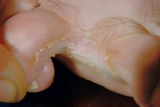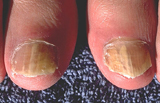Fungal Skin Infections (tinea, ringworm)
clickFungal infections are due to an overgrowth of fungus on the skin.
Microscopic-sized organisms called live normally on everyone’s skin without causing problems. In some instances they grow out of control and cause fungal infections of the skin, hair, and nails.
Fungal skin infection are very common. They are especially among children and teenagers, but can affect people of all ages.
Fungal infections can appear anywhere on the body and lead to a variety of symptoms depending on the type and location of fungi.
The symptoms of fungal skin infections include:
- Skin: Itchy, red, raised, scaly patches that may blister and ooze. The patches often have sharply-defined edges. They are often redder around the outside with normal skin tone in the center. This may create the appearance of a ring. Your skin may also appear unusually dark or light.
- Hair: If your scalp or beard is infected, you may develop bald patches.
- Nails: Fungal infections of the toenails or fingernails can cause the nails to become discolored and thick.
Some fungal infections are given unique names to describe their location or the type of fungi involved.
Ringworm
Fungal infections on the body is often referred to as “ringworm”. This is because the rash sometimes appears as a ring, or partial ring. This is a confusing and unnecessarily alarming name because the rash is not caused by a worm.
When ringworm appears on the body, it may be called “tinea corporis“. When it appears in the genital area, it is referred to as “jock itch” or “tinea cruris“.
When a fungal infectionappears on the scalp, it may be called “tinea capitis“. Tinea capitis can lead to hair loss.
Athlete’s Foot (tinea pedis)
 Athlete’s foot is a fungal infection of the feet and is very common between the toes. Feet that remain in shoes all day retain warmth and moisture, which promote the growth of fungi.
Athlete’s foot is a fungal infection of the feet and is very common between the toes. Feet that remain in shoes all day retain warmth and moisture, which promote the growth of fungi.
Onychomycosis (tinea uguium)
Onychomycosis refers to a fungal infection of the toenail or fingernail.
 Infections that involve the base of the nail (the nail bed) are more difficult to treat and often recur without sufficient treatment.
Infections that involve the base of the nail (the nail bed) are more difficult to treat and often recur without sufficient treatment.
Fungal nail infection may require the removal of part or all of the nail and/or the use of oral antifungal medications.
Tinea Versicolor
Tinea versicolor is a common and harmless fungal infection caused by Pityriasis versicolor. It appears on the back, chest, neck, and upper arms as light-colored patches of discolored skin.
Tinea Nigra
Tinea nigra is a fungal infection caused by specific type of fungi (exophiala phaeoannellomyces) found in the soil of tropical regions. The infection generally occurs in individuals prone to excessive sweating (hyperhidrosis). It appears as slowly expanding brown or black patches on the skin of the palms and/or soles.
How Are Fungal Infections Diagnosed?
Your physician will diagnose a fungal infection primarily based on the appearance of the skin.
A Wood’s lamp may be used to identify fungi that appear fluorescent under its blue light. The skin may also be scraped to obtain cells for examination under a microscope or for growth in a fungal “culture” that is sent to a lab for identification.
How Are Fungal Infections Treated?
Most cases of ringworm (jock itch and athlete’s foot) and and tinea versicolor can be treated effectively with antifungal medications applied to the skin (topical medications).
Tinea capitis often requires the use of an oral antifungal agent, such as griseofulvin, because the fungi can reside deep in the hair follicles and can’t be reached by topical medications.
Similarly, nail infections where the fungi have penetrated the nail bed may require an oral antifungal, though some specially formulated topical antifungals might be tried first.
Tinea nigra generally responds well to topical antifungal agents and peeling agents such as salicylic acid or topical retinoids.
The paper-thin patches of fungal overgrowth found with tinea versicolor can be treated effectively with topical antifungal solutions.
What Should I Expect from Treatment?
Topical medications applied to the skin are usually effective at treating fungal infections within 4 weeks. If your infection is severe or resistant (meaning that it does not respond well to self-care), it will usually respond quickly to oral medications.
How Can I Prevent a Fungal Infection?
Fungal infections on the skin are contagious. They can be passed from one person to the next by direct skin-to-skin contact or by contact with contaminated items such as combs, unwashed clothing, and shower or pool surfaces. You can also catch ringworm from pets that carry the fungus. Cats are common carriers.
Fungi thrive in warm, moist areas. Infections are more likely when you have frequent wetness (such as from sweating) and minor injuries to your skin, scalp, or nails.
To prevent fungal infections:
- Keep your skin and feet clean and dry.
- Shampoo regularly, especially after haircuts.
- Do not share clothing, towels, hairbrushes, combs, headgear, or other personal care items. Such items should be thoroughly cleaned and dried after use.
- Wear sandals or shoes at gyms, lockers, and pools.
- Avoid touching pets with bald spots. Wash your hands if you pet a stray animal.






